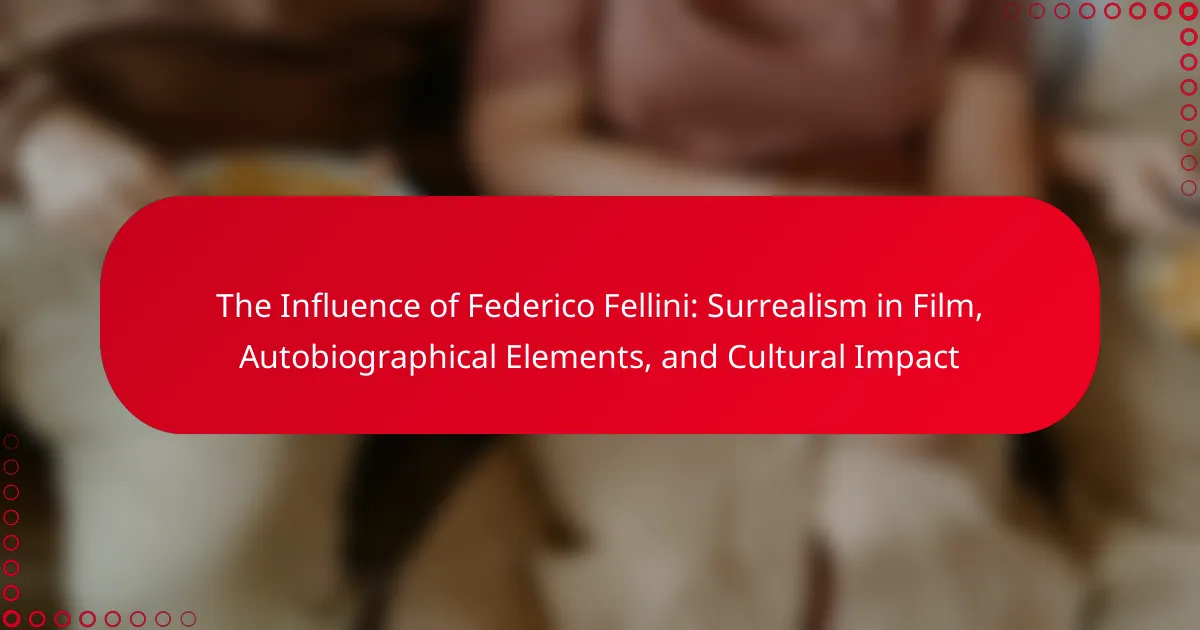Federico Fellini is a pivotal figure in film history, renowned for his innovative storytelling techniques and visual style that merge reality with fantasy. His films, including “La Dolce Vita” and “8½,” incorporate autobiographical elements, allowing for profound emotional engagement and reshaping narrative structures in cinema. Fellini’s influence extends to numerous filmmakers, evident in the works of directors such as Martin Scorsese and David Lynch, who draw inspiration from his unique approach. The article explores Fellini’s impact on global cinema, the portrayal of Italian culture, and his lasting legacy in the realm of artistic expression and narrative exploration. Key themes include surrealism, identity, memory, and the human experience, highlighting how Fellini’s contributions continue to resonate with audiences and filmmakers alike.

What is the Influence of Federico Fellini on Cinema?
Federico Fellini significantly influenced cinema through his unique storytelling style and visual aesthetics. His films often blend reality with fantasy, creating a surreal narrative experience. This approach inspired many filmmakers to explore similar themes in their works. Fellini’s use of autobiographical elements also reshaped narrative structures in film. He incorporated personal experiences, allowing for deeper emotional connections with audiences. His iconic films, such as “La Dolce Vita” and “8½,” are regarded as masterpieces that pushed the boundaries of traditional filmmaking. Fellini’s emphasis on character-driven stories has left a lasting legacy on cinematic storytelling. His impact is evident in the works of directors like Martin Scorsese and David Lynch, who cite him as a major influence.
How did Fellini’s style redefine narrative in film?
Federico Fellini’s style redefined narrative in film by integrating surrealism and personal autobiography. He blurred the lines between reality and fantasy, creating dreamlike sequences. This approach allowed for non-linear storytelling. His films often featured episodic structures rather than traditional plots. Fellini’s use of exaggerated characters added emotional depth. His narratives explored complex themes like identity and memory. Films like “8½” exemplified this innovative style, showcasing a filmmaker’s introspection. The impact of his narrative techniques influenced future directors and genres.
What are the key characteristics of Fellini’s storytelling approach?
Fellini’s storytelling approach is characterized by surrealism, autobiographical elements, and rich visual imagery. His films often blend reality with fantasy, creating dreamlike narratives. He frequently draws from his own life experiences, infusing personal memories into his storytelling. This autobiographical aspect adds depth and authenticity to his characters. Fellini’s use of vibrant imagery enhances emotional resonance. His scenes often feature elaborate set designs and striking costumes. Additionally, he employs unconventional narrative structures, prioritizing mood over linear storytelling. These characteristics have significantly influenced the film industry and inspired many filmmakers worldwide.
In what ways did Fellini’s films challenge traditional cinematic norms?
Fellini’s films challenged traditional cinematic norms through innovative narrative structures and visual styles. His works often blended reality with fantasy, creating a dreamlike quality. This approach diverged from conventional storytelling methods. Fellini frequently employed non-linear narratives, which disrupted the expected flow of events. He also utilized surreal imagery to evoke emotional responses rather than adhere to logical sequences.
Moreover, his characters often represented exaggerated archetypes, defying realistic portrayals. Fellini’s use of autobiographical elements blurred the lines between fiction and reality, further distancing his films from traditional norms. His iconic film “8½” exemplifies this, as it explores the creative process through a fragmented narrative. These techniques collectively redefined cinematic language and influenced future filmmakers.
What role did surrealism play in Fellini’s works?
Surrealism played a significant role in Federico Fellini’s works. It influenced his narrative style and visual aesthetics. Fellini often incorporated dream-like sequences and bizarre imagery. His films, such as “8½” and “La Dolce Vita,” showcase these surreal elements. The blending of fantasy and reality is a hallmark of his storytelling. Surrealism allowed Fellini to explore the subconscious and human emotions. This approach created a unique cinematic experience. Critics have noted the impact of surrealism on his character development and plot structures.
How does surrealism manifest in Fellini’s visual style?
Surrealism manifests in Fellini’s visual style through dreamlike imagery and fantastical elements. His films often feature bizarre, non-linear narratives that defy logic. For example, in “8½,” reality blends with fantasy, showcasing characters in surreal situations. Fellini employs striking visuals, such as exaggerated costumes and unexpected juxtapositions. His use of vibrant colors enhances the dreamlike quality of his scenes. Additionally, he integrates symbolic imagery that reflects subconscious desires and fears. This approach creates an immersive experience that resonates with viewers on an emotional level. Fellini’s unique style is a hallmark of surrealist cinema, influencing filmmakers worldwide.
What are some notable examples of surrealism in specific Fellini films?
Notable examples of surrealism in Federico Fellini’s films include “8½,” “La Dolce Vita,” and “Fellini Satyricon.” In “8½,” dream sequences blend reality and fantasy, showcasing the protagonist’s inner turmoil. “La Dolce Vita” features surreal imagery, such as the iconic scene of a statue of [censured] being carried through Rome. “Fellini Satyricon” presents a fragmented narrative filled with bizarre characters and dreamlike landscapes. These films exemplify Fellini’s unique style, merging the surreal with autobiographical elements, reflecting his personal experiences and societal observations.
How did autobiographical elements influence Fellini’s filmmaking?
Autobiographical elements significantly influenced Fellini’s filmmaking. His personal experiences shaped themes and characters in his films. For example, “8½” reflects his struggles with creativity and personal identity. Fellini often incorporated his childhood memories into narratives, creating a unique blend of reality and fantasy. His films frequently explore the tension between dreams and reality, mirroring his own life. The use of surreal imagery in his work often stems from his introspective nature. Critics note that this autobiographical approach adds depth to his storytelling. Fellini’s films resonate with audiences due to their emotional authenticity. This connection to his life experiences sets his work apart in cinema history.
What personal experiences shaped the themes in Fellini’s films?
Federico Fellini’s films were shaped by his childhood experiences in Rimini. His early life in a small Italian town influenced his depiction of nostalgia and memory. The themes of fantasy and reality in his works often reflect his personal struggles. Fellini faced challenges in reconciling his artistic ambitions with societal expectations. His experiences during World War II also impacted his storytelling, introducing darker themes. Additionally, his relationships with women informed his portrayal of complex female characters. Fellini’s fascination with the circus and performance art stemmed from his youth, enriching his cinematic style. These personal experiences collectively contributed to the surreal and autobiographical nature of his films.
How do autobiographical elements enhance character development in his works?
Autobiographical elements enhance character development in Federico Fellini’s works by providing depth and authenticity. His personal experiences often inform the motivations and emotions of his characters. This connection allows audiences to relate to the characters on a deeper level. For instance, Fellini’s childhood memories frequently shape the narratives in films like “Amarcord.” The use of autobiographical details makes characters more relatable and multidimensional. This technique invites viewers to engage with the characters’ struggles and triumphs. Additionally, it reflects Fellini’s own journey, adding layers of meaning to the storytelling. The integration of personal history enriches the emotional landscape of his films.

What is the cultural impact of Federico Fellini’s films?
Federico Fellini’s films have significantly shaped global cinema and culture. His unique narrative style blends surrealism with autobiographical elements. This approach has influenced filmmakers worldwide, encouraging them to explore personal and dreamlike storytelling. Fellini’s work has also impacted the portrayal of Italian culture, showcasing its complexities and eccentricities. His films often reflect themes of identity, memory, and the human experience. This has resonated with audiences, leading to a broader appreciation of art cinema. Fellini’s legacy continues through film festivals, retrospectives, and academic studies. His contributions have solidified his status as a cultural icon, inspiring generations of artists and filmmakers.
How has Fellini influenced contemporary filmmakers?
Federico Fellini has significantly influenced contemporary filmmakers through his unique storytelling techniques and visual style. His use of surrealism has inspired filmmakers to explore dreamlike narratives. Directors like David Lynch and Terry Gilliam often incorporate surreal elements reminiscent of Fellini’s work. Additionally, Fellini’s autobiographical elements encourage filmmakers to draw from personal experiences. This approach can be seen in films by directors such as Pedro Almodóvar and Spike Jonze. His emphasis on character-driven stories has shaped the way modern narratives are constructed. Many contemporary filmmakers prioritize character depth, similar to Fellini’s focus on complex characters. Furthermore, Fellini’s blending of fantasy and reality has encouraged a more fluid approach to storytelling in cinema. This influence is evident in films like “Eternal Sunshine of the Spotless Mind” by Michel Gondry. Overall, Fellini’s legacy continues to resonate in the works of contemporary filmmakers.
Who are some filmmakers that cite Fellini as an inspiration?
Many filmmakers cite Federico Fellini as an inspiration. Notable directors include Martin Scorsese, who admires Fellini’s unique storytelling style. Woody Allen has also expressed his respect for Fellini’s influence on cinema. Additionally, David Lynch often references Fellini’s surrealism in his work. Terry Gilliam acknowledges Fellini’s impact on his visual style. These filmmakers highlight Fellini’s significant role in shaping modern cinema. Their works reflect elements of Fellini’s artistry and thematic exploration.
What techniques or themes have been adopted from Fellini’s work?
Fellini’s work has inspired various techniques and themes in cinema. His use of surrealism is a prominent influence. This technique often blurs the line between reality and fantasy. Many filmmakers adopt this to create dreamlike narratives. Autobiographical elements are another key theme from his films. They reflect personal experiences and memories, resonating with audiences. Additionally, Fellini’s focus on character-driven storytelling is widely emulated. His unique visual style, characterized by vivid imagery and symbolism, also impacts filmmakers. These elements collectively shape modern cinematic language and storytelling approaches.
How did Fellini’s films reflect the cultural landscape of his time?
Fellini’s films reflected the cultural landscape of his time by addressing themes of identity, societal change, and the human experience. His works often depicted post-war Italian society, showcasing the struggles and aspirations of individuals. Films like “La Dolce Vita” highlighted the conflict between traditional values and modernity. This film, released in 1960, mirrored the existential crises faced by many Italians during the economic boom. Fellini’s use of surrealism illustrated the complexities of human emotions and desires. His characters often navigated a dreamlike reality, symbolizing the confusion of contemporary life. Additionally, his autobiographical elements provided insight into his personal struggles and the broader cultural zeitgeist. Overall, Fellini’s unique storytelling captured the essence of Italian society’s transformation during the mid-20th century.
What social issues did Fellini address through his films?
Federico Fellini addressed various social issues in his films. He explored themes of identity, often reflecting the struggles of individuals in post-war Italy. His works depicted the tension between tradition and modernity, highlighting societal changes. Fellini also focused on the absurdity of life, critiquing materialism and consumer culture. He portrayed the complexities of human relationships, including love, loneliness, and existential despair. Additionally, his films often comment on the role of the artist in society. Through surreal imagery, he challenged viewers to confront uncomfortable truths about society. These elements made his films a profound commentary on the human condition.
How did Fellini’s work resonate with audiences in different cultural contexts?
Fellini’s work resonated with audiences across various cultural contexts through its universal themes and innovative storytelling. His films often explored human emotions, dreams, and identity, appealing to a broad audience. The blending of surrealism and reality in his narratives allowed viewers from different backgrounds to connect with the deeper meanings. For instance, films like “La Dolce Vita” and “8½” addressed existential questions, relatable to diverse cultures facing modernity. Additionally, Fellini’s unique visual style and character-driven stories transcended language barriers. His influence extended globally, inspiring filmmakers and artists worldwide, as seen in the homage paid to his work in international cinema. This widespread appreciation highlights the cultural impact of Fellini’s artistic vision.

What are the lasting legacies of Federico Fellini in film history?
Federico Fellini’s lasting legacies in film history include his pioneering use of surrealism, the integration of autobiographical elements, and a profound cultural impact. His films often blend reality with fantasy, creating a dream-like narrative style. This approach has influenced countless filmmakers and altered the perception of storytelling in cinema. Fellini’s autobiographical elements reflect personal experiences, making his work deeply relatable and introspective. His signature style, characterized by vibrant visuals and complex characters, has set a standard for artistic expression in film. Additionally, his contributions have sparked discussions about the nature of reality in cinema, inspiring movements such as magical realism. Fellini’s work continues to resonate, proving his enduring influence on both audiences and filmmakers alike.
What awards and recognitions did Fellini receive throughout his career?
Federico Fellini received numerous prestigious awards throughout his career. He won five Academy Awards for Best Foreign Language Film. These films include “La Strada,” “Nights of Cabiria,” “8½,” “Amarcord,” and “The Voice of the Moon.” Fellini also received the Palme d’Or at the Cannes Film Festival for “La Dolce Vita.” In addition, he was awarded the Golden Lion at the Venice Film Festival for lifetime achievement. His unique style earned him recognition as a master of surrealism in cinema. These accolades solidified his influence on film and culture globally.
How do these accolades reflect his influence on the film industry?
Federico Fellini’s accolades reflect his significant influence on the film industry through recognition of his innovative storytelling and visual style. He won five Academy Awards for Best Foreign Language Film, showcasing his international acclaim. His film “La Dolce Vita” received the Palme d’Or at the Cannes Film Festival, highlighting his artistic impact. These honors demonstrate how his work reshaped narrative structures and character development in cinema. Fellini’s unique blend of surrealism and autobiographical elements inspired countless filmmakers. His legacy continues to influence modern storytelling techniques and cinematic aesthetics.
How can filmmakers learn from Fellini’s approach to storytelling?
Filmmakers can learn from Fellini’s approach to storytelling by embracing surrealism and personal narrative. Fellini often integrated dreamlike sequences into his films, creating a unique visual language. This technique allows filmmakers to explore deeper emotional truths beyond reality. Additionally, his use of autobiographical elements invites audiences to connect personally with the story. For example, in “8½,” Fellini reflects on his creative struggles, which resonates with many artists. By blending fantasy with reality, filmmakers can create more compelling and relatable narratives. This approach encourages innovation and emotional engagement in storytelling.
What practical techniques can be adopted from Fellini’s filmmaking style?
Fellini’s filmmaking style incorporates several practical techniques. One technique is the use of dreamlike sequences. These sequences blur the lines between reality and imagination. They create an emotional resonance that engages viewers. Another technique is the incorporation of autobiographical elements. This adds personal depth to the narrative. Using vibrant visuals is also a hallmark of Fellini’s style. His films often feature rich colors and striking imagery. Additionally, he employs a non-linear storytelling approach. This technique allows for a more fluid exploration of themes. Finally, the use of exaggerated characters adds to the surreal quality of his films. These techniques contribute to the unique storytelling style that Fellini is known for.
How can understanding Fellini’s work enhance a filmmaker’s creative process?
Understanding Fellini’s work can enhance a filmmaker’s creative process by inspiring innovative storytelling techniques. His use of surrealism encourages filmmakers to explore imaginative narratives. Fellini’s autobiographical elements demonstrate the power of personal experiences in filmmaking. This approach allows filmmakers to connect deeply with their audiences. His distinctive visual style showcases the importance of aesthetic choices in film. Filmmakers can learn to blend reality with fantasy, creating unique cinematic experiences. Additionally, Fellini’s exploration of cultural themes can guide filmmakers in addressing societal issues. Overall, studying his work fosters creativity and originality in film production.
Federico Fellini is the main entity of this article, which explores his profound influence on cinema through surrealism, autobiographical elements, and cultural impact. The article details how Fellini’s unique storytelling style and visual aesthetics blend reality with fantasy, redefining narrative structures in film. Key characteristics of his work, such as episodic storytelling and exaggerated characters, are examined alongside specific examples from his iconic films like “La Dolce Vita” and “8½.” Additionally, the article discusses the lasting legacies of Fellini’s techniques and themes, highlighting their significance in shaping contemporary filmmaking and addressing social issues within the cultural landscape of his time.
